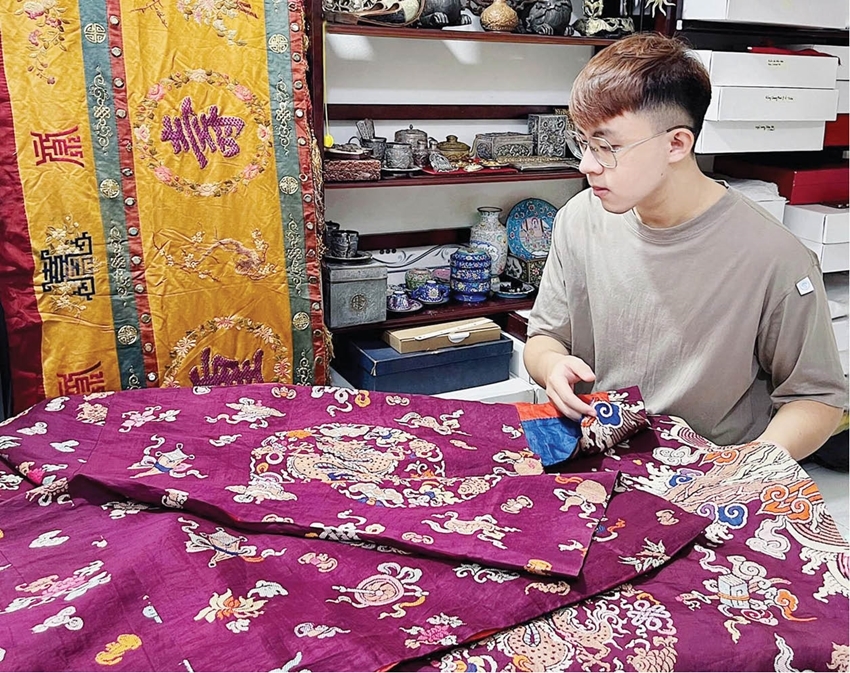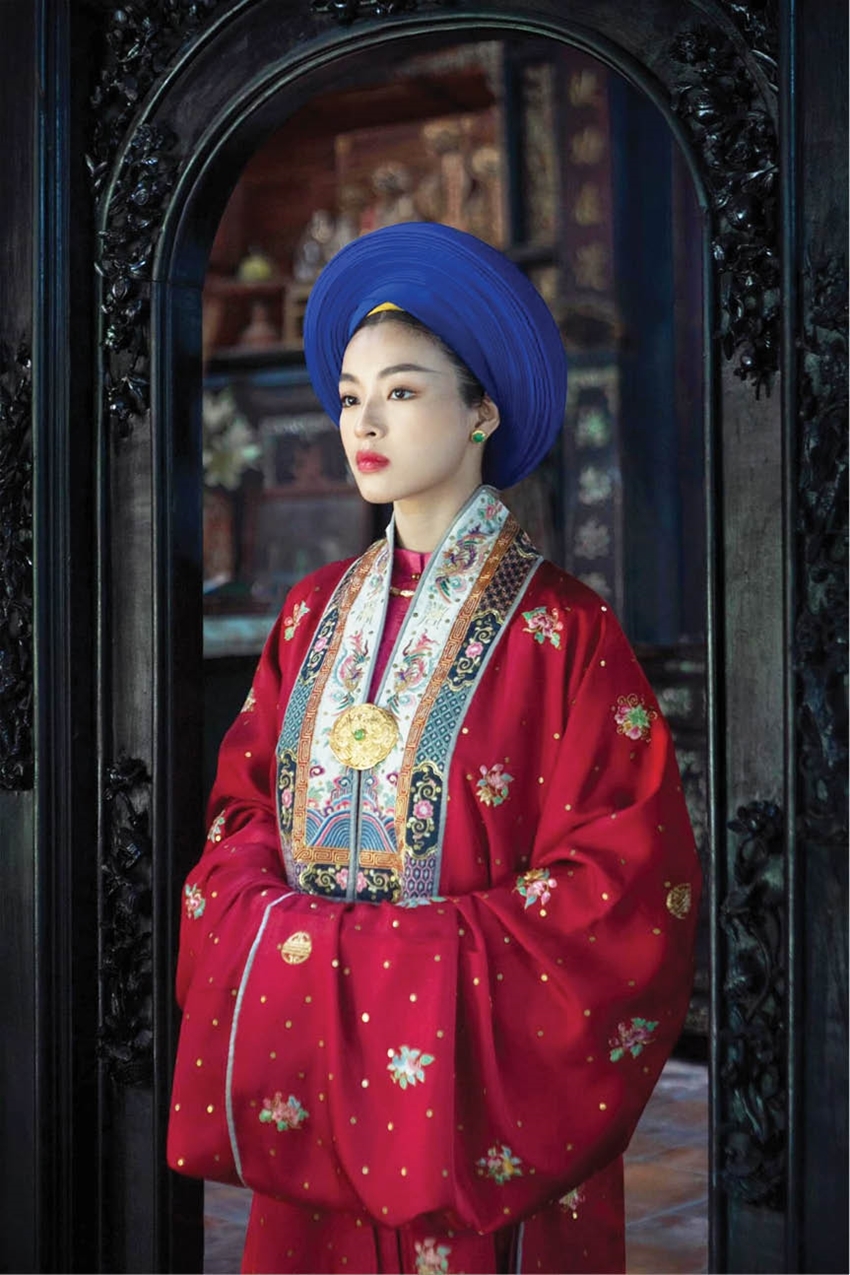 |
| La Quoc Bao meticulously tends to every detail on the Nhat Binh Ao dai. Photo: La Quoc Bao |
Preserving the old spirit
"Hoa Quan Le Phuc" is a series of projects to revive the Nguyen dynasty costumes with full dedication by La Quoc Bao and his colleague Nguyen Phung Minh Luan, a special effects specialist living abroad, who have invested in and pursued this endeavor for many years. The first piece is a revival of the Nhat Binh Ao dai worn by Empress Consort Nam Phuong. This is a work that Bao and Luan drew inspiration from a photo of Empress Consort Nam Phuong wearing a red Nhat Binh Ao dai at the Cong Quan Palace.
Introducing the project, La Quoc Bao says: "Though simple and unassuming, it is very special because it is the first ceremonial costume worn by Empress Consort Nam Phuong at her wedding with Emperor Bao Dai on March 20, 1934. The Ao dai is a 'historical witness' along with Miss Nguyen Huu Thi Lan - the daughter of a famous tycoon in Indochina, who, after the era of reforms, officially ascended the role of queen with the royal title Nam Phuong."
To infuse the ancient mystical spirit into the Ao dai, Quoc Bao had to experiment many times and move continuously between Ho Chi Minh City - Hue - Hanoi to study, reference, and achieve the most beautiful and accurate portrayal possible. From the embroidery to the red fabric, all were made from silk, embroidered, and hand-bordered with gold thread for nearly 6 months. The accompanying jewelry and accessories were also researched and handcrafted in traditional craft villages. The Ao dai was entirely handmade by artisan Tran Le Trung Hieu, with the embroidery done by artisans in Hue. Quoc Bao explains: "After designing, I took it to Hue for embroidery because the artisans here have been exposed to court costumes since childhood, so they are familiar with traditional aesthetic embroidery techniques. They won't overlook the tiny details that make up the distinctly Vietnamese patterns, so the product has a soul."
In addition to Empress Consort Nam Phuong's Nhat Binh Ao dai, the "Hoa Quan Le Phuc" project also revived the Nhat Binh Ao dai of Mrs. Thai Thi Hue Khanh in the collection of Professor Thai Kim Lan. With this piece, Quoc Bao's team did not reconstruct the original shirt but borrowed patterns, colors, and decoration styles from the past to create a different Nhat Binh Ao dai. In addition, Quoc Bao's team is also reviving 2 male ceremonial costumes that are currently in the final stages of completion.
According to Quoc Bao, the choice to "revive" rather than "reconstruct" the ceremonial costumes is because these designs carry a touch of the era, based on existing ancient costumes. The works still ensure craftsmanship and tailoring in the ancient style, meeting the standards of court costumes, albeit with some support from modern technology in pattern drawing. He emphasizes: "In these works, we aim to integrate and interweave the personal artistic touches of the artists. However, when viewing them, the audience can still feel the ancient spirit, the essence of the predecessors in the silhouette of the Ao dai’s that have contributed to the historical cultural flow in the purple palace."
 |
| Empress Consort Nam Phuong's Nhat Binh Ao dai reproduced by La Quoc Bao and his team. Photo: La Quoc Bao |
Trying to get close to history
Born in Kien Giang, La Quoc Bao grew up in a family involved in traditional cultural activities; so, from a young age, he was attached to ancient cultural values. When studying architecture abroad in Australia, during visits to museums and galleries for essays, Bao began to be interested in learning about Nguyen dynasty culture. In his second year of study, Bao started his own shoe business called Baro and thought of incorporating Nhat Binh Ao dai patterns onto shoes. Surprisingly, the product was warmly received by customers. "When putting a pattern on a product, I also have to know how to interpret and introduce it so that when customers look at it, they know where this pattern comes from and what it means. From this collection to another, I gradually became passionate about the art and history of the Nguyen dynasty," says Quoc Bao.
Quoc Bao and Minh Luan visited the Hue Royal Antiquities Museum, where they listened to Dr. Huynh Thi Anh Van, the museum's director at the time, introduce the process of reconstructing Nguyen dynasty costumes. The two young men were enthusiastic and also wanted to try it out. However, accessing artifacts for research in museum or private collections was quite difficult due to special preservation requirements. Therefore, Quoc Bao collected and built his own collection for reference, mostly about fabrics, embroidered paintings, and ancient costumes ... Gradually, Bao became a collector of the Nguyen dynasty art without even realizing it. In Quoc Bao's collection there is a princess' phoenix shirt, one of the rarest artifacts in Vietnam. Another important artifact that played a significant role in helping Bao reproduce the Nhat Binh Ao dai is the phoenix button. This is the second phoenix button in Vietnam, besides the first one belonging to Hue Royal Antiquities Museum.
After a period of in-depth research to recreate court costumes with the attitude of trying to be as historically accurate as possible, Quoc Bao believes that the most difficult part is finding documentation, followed by finding fabric materials to reproduce. Initially, Quoc Bao thought that any fabric would do, but upon further investigation, he realized that in the past, craftsmen used unprocessed silk, so the fabric was different from that of today, and when embroidered, it produced different effects. For the first piece, Quoc Bao's team had to remake it several times before succeeding.
The Nguyen dynasty costumes are a prime example of the aesthetics and craftsmanship of the ancients. Even embroidery, the people of Hue have their own style, their own color palette. Quoc Bao shares: "The main purpose of the 'Hoa Quan Le Phuc' project is to revive Nguyen dynasty art through Nhat Binh Ao dai’s, ceremonial costumes, conical hats, and belts... so that people can see the beauty of the past. All the pieces are handmade, all the details on the shirts are meticulously executed to achieve the utmost integrity."